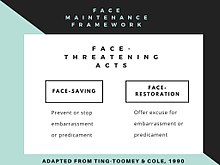
Face negotiation theory is a theory conceived by Stella Ting-Toomey in 1985, to understand how people from different cultures manage rapport and disagreements.[1] The theory posited "face", or self-image when communicating with others,[1] as a universal phenomenon that pervades across cultures. In conflicts, one's face is threatened; and thus the person tends to save or restore his or her face. This set of communicative behaviors, according to the theory, is called "facework". Since people frame the situated meaning of "face" and enact "facework" differently from one culture to the next, the theory poses a cross-cultural framework to examine facework negotiation. It is important to note that the definition of face varies depending on the people and their culture and the same can be said for the proficiency of facework.[2] According to Ting-Toomey's theory, most cultural differences can be divided by Eastern and Western cultures, and her theory accounts for these differences.
- ^ a b Cite error: The named reference
Ting-Toomeywas invoked but never defined (see the help page). - ^ Littlejohn, S., Foss, K. (2011). Theories of Human Communication (10 ed.). Long Grove, IL: Waveland Press. p. 203. ISBN 978-1-57766-706-3.
{{cite book}}: CS1 maint: multiple names: authors list (link)